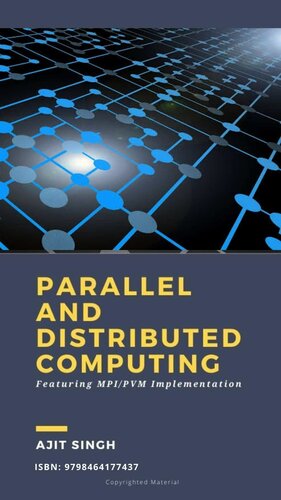

Most ebook files are in PDF format, so you can easily read them using various software such as Foxit Reader or directly on the Google Chrome browser.
Some ebook files are released by publishers in other formats such as .awz, .mobi, .epub, .fb2, etc. You may need to install specific software to read these formats on mobile/PC, such as Calibre.
Please read the tutorial at this link: https://ebookbell.com/faq
We offer FREE conversion to the popular formats you request; however, this may take some time. Therefore, right after payment, please email us, and we will try to provide the service as quickly as possible.
For some exceptional file formats or broken links (if any), please refrain from opening any disputes. Instead, email us first, and we will try to assist within a maximum of 6 hours.
EbookBell Team

0.0
0 reviewsThis text
is an introduction to the complex and emerging world of the Parallel and
Distributed Computing. It helps you understand the principles and acquire the practical
skills of MPI programming using the C/FORTAN programming language. My aim is
for you to gain sufficient knowledge and experience to perform simple useful
programming tasks using the best up-to-date techniques and so we hope for it to
be the easiest book from which you can learn the basics of MPI programming. It
helps you understand the principles, algorithm & implementation of Parallel
and Distributed Computing.
This book
is emphatically focused on the concept. Understanding the fundamental ideas,
principles, and techniques is the essence of a good programmer. Only
well-designed code has a chance of becoming part of a correct, reliable, and
maintainable parallel system. Through this book, I hope that you will see the
absolute necessity of understanding Parallel and Distributed Computing.
I have
taken a top-down approach, addressing the issues to be resolved in the design
of parallel and distributed systems and describing successful approaches in the
form of abstract models, algorithms and detailed case studies of widely used
systems.
The book
aims to provide an understanding of the principles on which the parallel and
distributed computing are based; their architecture, algorithms and design; and
how it meets the demands of contemporary distributed applications. I began with
a set of chapters that together cover the building blocks for a study of
parallel and distributed systems. The first few chapters provide a conceptual
overview of the subject, outlining the characteristics of parallel and distributed
systems and the challenges that must be addressed in their design: scalability,
heterogeneity, security and failure handling being the most significant. These
chapters also develop abstract models for understanding process interaction,
failure and security.